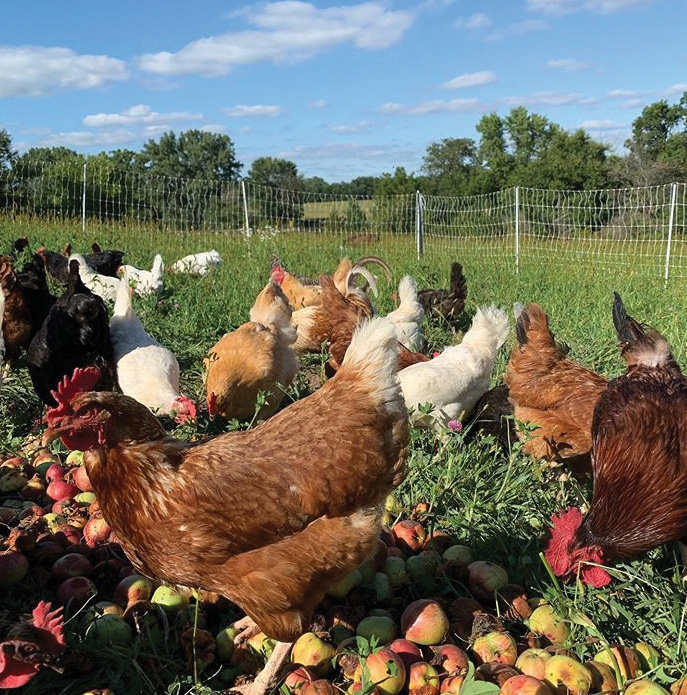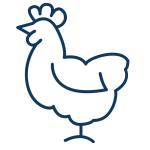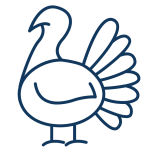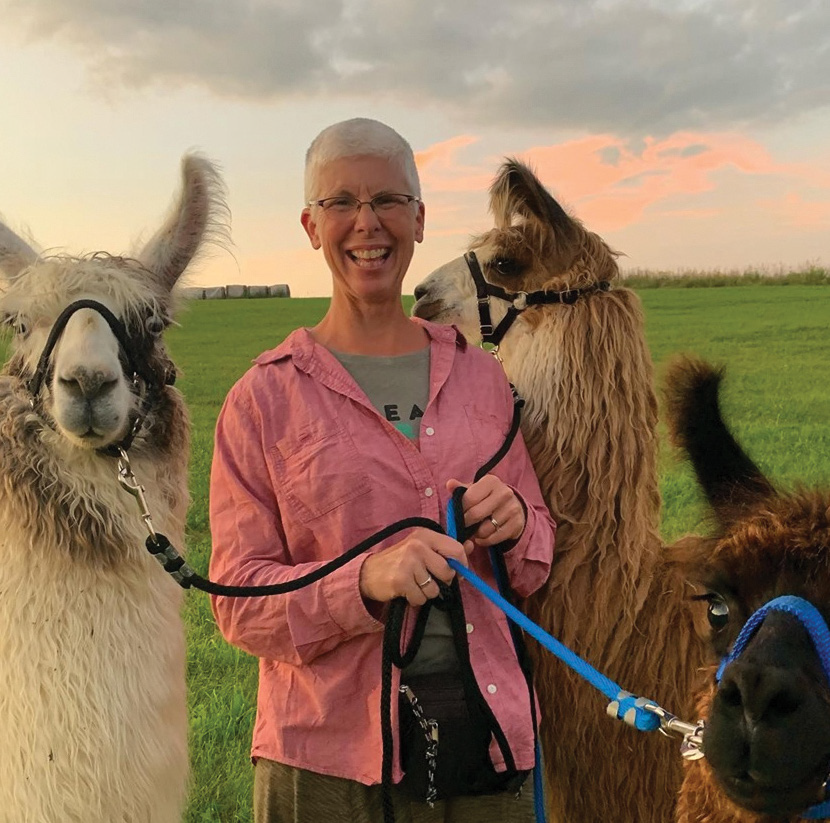The Birds and the Trees
At Lucky Star Farm, Susan Young is integrating poultry and silvopasture
Inspired by their daughter’s entrepreneurial spirit to start an egg business, Susan and Rick Young, near Iowa City, acquired laying hens and began farming in 2011. The Youngs started selling eggs to friends, family and neighbors. As word got out and demand increased, they soon needed to expand – in addition to chickens, Lucky Star Farm now includes Broad Breasted White and heritage breed turkeys, llamas and goats.
As business sprouted, Susan searched to find a solution on how to scale up egg production while also improving their farmland. By raising the laying hens on pasture, she was able to increase her flock to 150 layers. But then the birds were exposed to predators and fluctuating weather. Susan began to observe how the hens would huddle in their shelter during hot days and how this was affecting their laying rates.
“I began to look for solutions to help keep our birds cooler, especially with Iowa’s changing climate,” she explains. “We are more frequently experiencing extreme heat and extreme cold here in Iowa.”
Silvopasture for a Changing Climate
In her research, she came across the concept of silvopasture, where trees, livestock and forages are integrated as a whole system. The combination of trees and pasture work symbiotically to provide food and shelter for livestock. Poultry can be integrated with young trees when establishing a silvopasture system to provide nutrients for the trees in return for shelter and shade.
Silvopasture systems are created by either introducing forages into a woodland or orchard or by planting trees in pasture. Steve Gabriel is an ecologist, forest farmer, educator and author. In his book “Silvopasture,” he shares how this system offers not only the promise of ecological regeneration of the land, but also an economic livelihood and the ability to farm extensively while adapting to a changing climate.

Chickens at Lucky Star Farm feast on apples in the pasture. Susan is starting to plant trees in her pasture to develop a silvopasture system for her poultry.
For Susan, this is a big reason why she’s venturing into silvopasture: “The concept of pasturing animals among the trees deeply resonated with me in trying to establish a mutual ecosystem that is beneficial for both the land and livestock.”
Joe Klingelhutz, a farm and realty specialist with the Sustainable Iowa Land Trust who spoke at a September field day Susan hosted about raising poultry on pasture, noted: “Poultry is a great livestock choice to begin silvopasture with because they give the young trees time to grow with minimal disturbance, unlike larger livestock.”
Sequestering Carbon
Project Drawdown, a global non-profit research organization that analyzes and identifies climate solutions, ranks silvopasture as the ninth most effective system for carbon sequestration, ranking above regenerative agriculture (11th) and conservation agriculture (16th). The project’s research suggests silvopasture far outpaces any grassland technique for counteracting the methane emissions of livestock and sequestering carbon “under hoof.”
With the ability to store carbon in both woody and fibrous biomass as well as soil, pastures with trees can sequester more carbon compared to pastures of the same size that are treeless. Project Drawdown estimates silvopasture is currently practiced on 351 million acres of land globally.
They also estimate that if silvopasture expanded to 554 million acres by 2050, carbon dioxide emissions could be reduced by 31.2 gigatons – the equivalent of about 3 years’ worth of global carbon emissions at the current rate. This equals about 2 tons of carbon per acre per year captured by the soil and biomass within a silvopasture system.
In his book, “Silvopasture,” Steve Gabriel discusses each type of poultry and the advantages and disadvantages each brings to silvopasture:

Chickens, following grazing animals, will break apart manure clusters while also consuming any remaining insects and larvae. Chickens must be closely monitored around newly planted trees, and need to be rotated frequently to avoid their over tilling of soil, but can be used to “till” up areas in order to establish new seedbeds.

Turkeys use a wider range of forage legumes and fallen fruits than chickens. Their ability to hunt precisely helps to address pest problems around the farm, especially with crop trees. The challenge with turkeys is their vulnerability to disease during their first months.

Guinea hens have an expert ability to forage and consume pests without engaging in the intense tilling and scratching characteristic of chickens and turkeys. Due to their wild nature, guinea fowl avoid returning to a coop and prefer to roost in trees, leaving them vulnerable to predation.
 Ducks can survive without constant access to open water, but small gallon tubs that are filled and emptied daily can serve their needs. Ducks forage by digging in the soil or muck with their beaks, and can consume a variety of pests including slugs and snails.
Ducks can survive without constant access to open water, but small gallon tubs that are filled and emptied daily can serve their needs. Ducks forage by digging in the soil or muck with their beaks, and can consume a variety of pests including slugs and snails.

Geese have been found to be more effective than chickens in their capacity to weed, control pests and avoid damaging crops. Of all the poultry, geese are able to sustain themselves off of pasture alone. However, their aggressive behavior can be problematic, especially during breeding season. With a careful breed selection, along with training, their aggression can be minimized.
Matching Trees to Your Soil Type
Susan developed goals for integrating trees into her pastures as part of the business plan she developed while participating in PFI’s Savings Incentive Program in 2017. Through SIP, Susan was paired with mentors Tom Wahl and Kathy Dice of Red Fern Farm in Wapello.
“From Tom and Kathy, I learned about which trees were beneficial for shade and would support the farm’s landscape,” Susan says.
“With SIP funding, I was able to put in water lines, fencing and began the venture of implementing silvopasture by planting 20 chestnut trees in the pastures.”
After attending PFI’s pre-conference short course on silvopasture in 2019, Susan began to look into additional technical and financial assistance that would help her establish trees on the farm. Joe Dixon, a district conservationist in Johnson County with Natural Resources Conservation Service, spoke at Susan’s 2019 field day and shared that NRCS has a variety of services that can help farmers establish trees.
“We are hoping in time to continue planting a variety of tree species,” Susan says. “With more help from Joe and NRCS services, we plan to add more trees along the hillside of our pasture in rows, and move our chickens in between those rows of trees.”
Before selecting and planting trees, your local NRCS conservationists will offer technical assistance, at no cost, for designing a silvopasture system for your farm. The conservationists can help with site preparation, tree planting, seeding, contouring, planting grass and developing a grazing plan. They will also explain if you are eligible for any state or federal programs that provide financial assistance.
It’s important to note that NRCS will only provide financial assistance for trees that match your farm’s soil type; it will not fund all crop trees. The “Iowa Woodlands Suitability Recommendations” manual from the Iowa NRCS and Iowa Department of Natural Resources, lists tree and shrub species suited to specific soil types in Iowa.
“Trees that are not listed by the Iowa DNR do not mean that they won’t make it,” Joe Dixon says. “It’s just that with taxpayer funding, the NRCS would like to ensure that the trees planted have a good chance of survivability. If you have your heart set on a certain tree species and you don’t have the soils that can support them, we can’t provide cost-share for those trees. Instead, you could balance some crop trees with native ones.”

